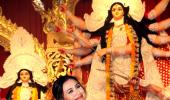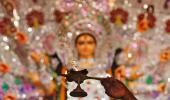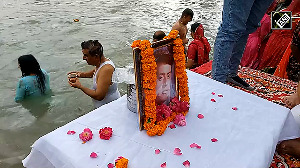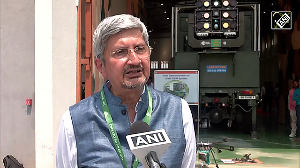There's a lot more to the festival than just five days of celebration; that is something you can only experience when you live in Kolkata.
And that's what every Bengali living outside the state misses, notes Chitrangada Datta Chaudhuri.

I'm back in Kolkata after 10 years and the memories are flooding back as the city celebrates our biggest festival.
It starts with 'Ma ashche (Maa Durga is arriving)' and ends with 'Asche bochor abar hobe (Maa Durga will arrive again next year)'.
Durga Pujo may be a five-day festival but it's only when you return home that the realisation hits hard -- it's not just a five-day love-affair. There's a lot more to the festival and that is something you can only experience when you live here, in Kolkata. And that's what every Bengali living outside the state misses.
Shashti to Dashami is when Bengalis, non-Bengalis -- anyone staying in Kolkata -- deck up to go see the pandals, stuff their face with food at the numerous stalls dotting the city, buy knick-knacks and try your hand at mela games.
Let's not forget the para adda (local hangout), where we catch up with our locality friends and stay up till the wee hours of the morning.

The pandals, the idols, the lights, the hoardings...
The build-up to the pujo is even more exciting.
Seeing the city being decked up is such a wholesome experience that it is difficult to capture it in words. But let me try.
Pujo generally arrives late September or October, but the preparations begin in June or even earlier.
The first sign that pujo asche is when you see trucks carrying bamboo canes for the pandals moving all over the city. This sight excites not just children but adults as well as we share the news with our loved ones, 'Baansh porche (The bamboo canes are being laid down)'. This is the first visible sign that the pandals are being 'created'.
We Bengalis are a creative bunch. And an adamant one at that.
We all want our pujo to be the best, our pandals to be the most unique, our Durga Thakur to be breathtaking.
After months of planning, the 'construction' of the marvellous pandals get underway.
First, the bamboo sticks are tied together for the basic structure. Then, the decorations begin and, boy, the things that are used -- from wires to bulbs to phuchkas to biscuits!
Each pandal is unique.
Also, let's not forget the awards for the pandals, which cover several categories!
Winning one, or more, is a matter of pride and pujo committees are very serious about this. To be part of the race, one must wear their thinking caps and build the most unique pandal possible!
With the pandals under construction, next step are the hoardings and the lights that go up all over the city. If you're lucky enough to fly into Kolkata at night during Pujo, the view from the sky is unparalleled!
The air has a nip in it; not the winter kind, but that of pujo ashche.
The malls and markets, including the iconic New Market, are packed as people head out to do their pujo shopping. And that, let me tell you, is a very important part of our pujo preparations.
For kids, it's essential to have 10 new outfits. They need two outfits a day -- a simpler one for the morning and a fancy one for the evening. The Ashtami and Navami outfits must be the best of the lot!
Parents make a list of the number of clothes that need to be bought. It's a tradition. We must buy clothes for the kids and the elders of our family.
Buying pujo jama (pujo clothes) for your parents once you start working is not just tradition or a ritual, it's an emotion.
The pujo shopping is spread over days. Traffic jams increase as a result, but the frustration stays away because... pujo ashche!
Oh, how can I forget the rehearsals in the build-up to the pujo!
We all must perform on stage -- be it singing, dancing, a skit or reciting a poem.
A month before pujo, we all gather in some neighbour's house to practice for an all-important show.

Maa Durga arrives...
Soon, the resplendent idols -- Maa Durga with her children, Goddess Laxmi, Goddess Saraswati, Lord Ganesha and Lord Kartikeya -- head to the pandals.
The kumortoli (idol makers) add their final touches and budding photographers take pictures.
Most of the idols have their eyes covered. The newspaper wrapping from the eyes come off with the bodhon ceremony or, nowadays, when the pandal is inaugurated.
Mahalaya marks the beginning of the festivities and the arrival of Maa Durga. Devotees perform tarpan in the Ganga.
We're all up early so that we are ready by 4 am to listen to Mahishasura Mardini in the booming voice of Birendra Krishna Bhadra.
Thus begin the festivities.

The lights, the dhaak, the food...
Nowadays, the pandals are inaugurated way before Shasti so people start pandal hopping before the actual rituals, trying to miss the bheer (crowd).
But the bheer is part of the fun.
Waiting for hours to just get a glimpse of the Thakur and the pandal is a big part of the pujo. A lot of planning goes into this. One needs to chalk out the route, the mode of transport, the must-see pandals and the ones you can skip if necessary.
And let's not forget the food -- and the must-go-to joints -- that's such a big part of our lives.
The dishes you must try during pujo include rolls, phuchka -- yes, you are allowed a phuchka dinner during pujo -- fish fry, bogher kichuri (the kichuri served at the pandals, it's fantastically tasty) and ice cream.
And the deadline? None of us head home before 3 am or 4 am.
After pandal hopping, the para adda is a must. The gossip revolves around the food, the pandals, the outfits and oh, the new boy or girl they saw as the para kakus and kakimas (neighbourhood uncle and aunts) keep an eye on you.

Nowhere but Kolkata...
Kolkata doesn't sleep during pujo! You don't get that in any other city.
I lived in Bengaluru for 10 years before recently moving back to Kolkata.
While there are several pujo celebrations in Bengaluru, it does not match the grandeur with which Kolkata welcomes this festival.
I remember, one year, after wrapping up work around 11.30 pm, we headed towards a well-known Durga pandal in Koramangala. It broke our hearts to see the lights being switched off and the cops asking people to wrap up the festivities because of the deadline. It was a far cry from pujo in Kolkata.
That's probably why Bengalis want to head home for this festival.
Even though the airfares skyrocket, they book their tickets.
And it's time to say goodbye...
Waking up to the sound of the dhaak (drum) on Shasti sends goosebumps down your spine and, if you're hearing it after years, tears to your eyes.
The pujo days pass by in a blur as we try to take in as much as possible.
Doshomi or Dussehra sees Bengali women wear the traditional white saree with red border as we bid farewell to Maa Durga.
The procession to the Ganga is a big part of the farewell as cries of 'Aasche bochor abar hobe' fill the air.
The dhaakis (drummers) and bhaashan (immersion) dance take over as the biswarjan takes place.
People line up the streets as they soak in the atmosphere.
On this day, many of us wait at the Deshapriya Park crossing because all the big pandals take their procession past that crossing. It's a feast for the eyes.
Ballygunge Cultural -- one of the most famous pandals in the city -- has a special ritual. All the ladies don white sarees with red borders while the men wear traditional white kurtas and they look stunning.
As Kolkata bids a teary farewell to Maa Durga, the unlucky ones who need to leave town head back to their respective cities.
But we ensure that we will return next year because 'Aasche bochor abar hobe (Maa Durga will arrive again next year)'.











 © 2025
© 2025